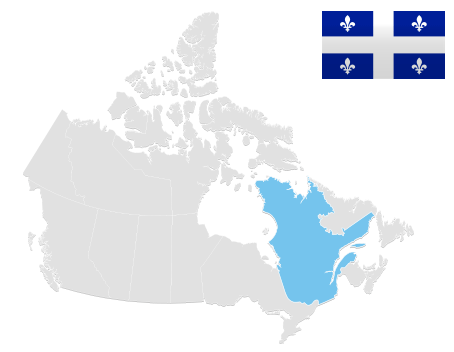Quebec’s Shale and Tight Resources

A product of the Energy and Mines Ministers’ Conference
Quebec’s Oil and Gas Resources

- N/A TRILLION CUBIC FEET
Technically Recoverable Natural Gas

- N/A MILLION BARRELS
Technically Recoverable Crude Oil

- 0 BILLION CUBIC FEET/DAY
Total Natural Gas Production (2015)- 0 BILLION CUBIC FEET/DAY
Shale/Tight Gas Production (2015)
- 0 BILLION CUBIC FEET/DAY

- 0 MILLION BARRELS/DAY
Total Crude Oil Production (2015)- 0 MILLION BARRELS/DAY
Tight Oil Production (2015)
- 0 MILLION BARRELS/DAY
- The limited number of wells drilled to date has not yet made it possible to specify oil and gas potential. Moreover, there is currently no commercial production of crude oil or natural gas in Quebec.
Source:
- Resource estimates: not available
- Production estimates: National Energy Board (may not align with provincial data due to differences in methodology)
Geography
Shale Gas
Utica shale occupies nearly 16,000 square kilometres in the St. Lawrence Lowlands (SLL). It covers the administrative regions of Montérégie, Centre-du-Québec and Chaudière-Appalaches.
Shale Oil
Macasty shale is found on Anticosti Island. This island is located in the northern part of the Gulf of St. Lawrence and has an area of approximately 7,900 square kilometres.
Geology
Shale Gas
Utica shale, which is found in the St. Lawrence Lowlands, is a fine-grained argillaceous sedimentary rock with low porosity and permeability that contains variable proportions of other minerals, such as quartz and calcite, which determine whether the shale is conducive to fracturing. Utica shale has been subdivided into two distinct geological formations, Lower Utica and Upper Utica, with the second exhibiting more gas potential. Utica shale is older and thicker than its North American equivalents. However, it is less porous and contains less organic matter, except in the flakes located east of Logan’s Line. Its low clay content makes it conducive to fracturing. Conversely, the Lorraine shale that overhangs it contains more gas, but its greater clay content and its low permeability tend to limit its fracturing and gas recovery potential.
Shale Oil
Anticosti Island belongs to a sedimentary basin of the Lower Paleozoic that encompasses all the surface and subsurface rocks of the island down to the Precambrian bedrock of the Canadian Shield. The sedimentary basin extends beneath the Gulf of St. Lawrence to the Côte-Nord region and into the Havre-Saint-Pierre region, eastward almost to Newfoundland, and southward and westward to a fault zone located under the St. Lawrence, which separates it from the Appalachians. Macasty shale has been identified as the mother rock of the hydrocarbons of the Anticosti Island sedimentary basin. It could contain major oil-bearing potential, comparable to that of the Ohio Utica shales, of which it would be the lateral equivalent.
Exploration and Production
Shale Gas
From 2006 to 2010, 29 wells were drilled in Utica shale. They included 18 vertical wells and 11 horizontal wells. Eighteen wells were fractured (11 vertical wells and 7 horizontal wells). A moratorium was imposed in 2013 on shale gas exploration activities in the St. Lawrence Lowlands.
Shale Oil
The Anticosti Island territory has been the focus of exploration campaigns since the 1960s. The recent exploration work targeted Macasty shale. In 2014, five stratigraphic surveys were completed. Seven others were conducted in 2015 for a total of twelve. The presence of Macasty shale was confirmed . During these surveys, several gas and oil fluorescence indices were encountered. Pétrolia Anticosti Inc. is planning the drilling and fracturing of three horizontal wells during the summer of 2016, subject to obtaining the necessary authorizations. In this regard, recall that under the Regulation respecting the application of the Environment Quality Act (RRAEQA), all drilling authorized under the Mining Act intended to explore for or extract petroleum or natural gas in the shale as well as any fracturing operation intended to explore for or extract oil or natural gas is subject to section 22 of the Environment Quality Act (EQA).
Regulation
In Quebec, oil and gas exploration activities require the obtaining of permits and authorizations issued by the Ministère du Développement durable, de l’Environnement et de la Lutte contre les changements climatiques (MDDELCC) and the Ministère de l’Énergie et des Ressources naturelles (MERN).
The MERN is responsible, in particular, for the application of the Mining Act and the Regulation respecting petroleum, natural gas and underground reservoirs. This is the legislative and regulatory framework under which exclusive exploration rights and, if applicable, exclusive development rights are granted by the MERN. This framework also sets out the financial and technical conditions and obligations to which the exercise of these rights is subject, including exploration for petroleum, natural gas, brine and underground reservoirs.
The MDDELCC’s primary responsibilities arise from the application of the Environment Quality Act (EQA) and its regulations. The MDDELCC regulates site development, drawing of water, management of residual materials, use of flares, greenhouse gas emissions, environmental emergency measures and site restoration at the end of the work.
Companies that wish to conduct exploration or development activities in rural areas must obtain prior authorization from the Commission de protection du territoire agricole du Québec (CPTAQ). Its mission is to guarantee that future generations will be able to rely on land that lends itself to the exercise and development of agricultural activities. For this purpose, it is in charge of the application of the Act respecting the preservation of agricultural land and agricultural activities. This Act specifies that only the CPTAQ may authorize a business to use any part of agricultural land for purposes other than agriculture or to remove topsoil. The same applies to felling trees in a sugar bush or the use of a sugar bush for purposes other than harvesting sap.
In July 2014, a ministerial order establishing the conditions and obligations regulating exploration for petroleum, natural gas and underground reservoirs on Anticosti Island was issued by the Quebec Government. Only stratigraphic surveys can be conducted under this ministerial order.
Public Research
Energy and Mines Ministers’ Conference
Energy and Mines Ministers’ Conference
Page details
- Date modified:
